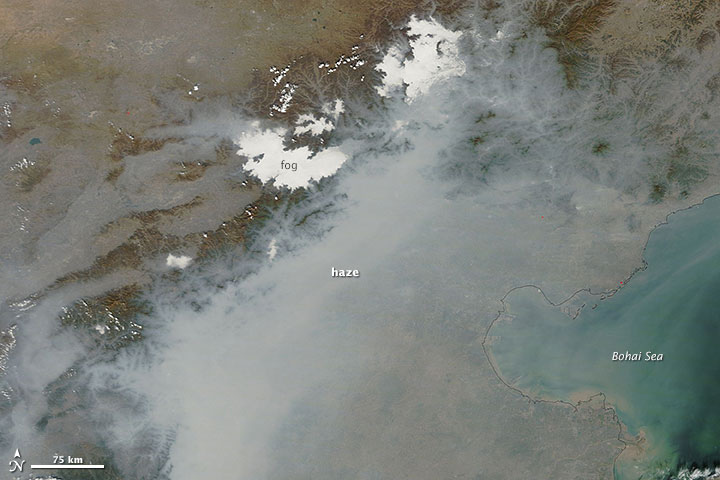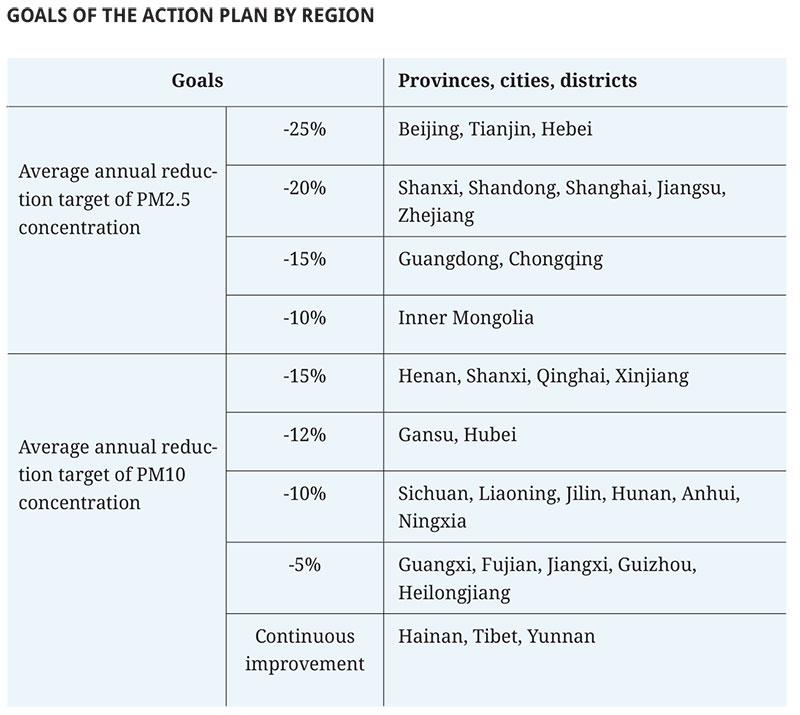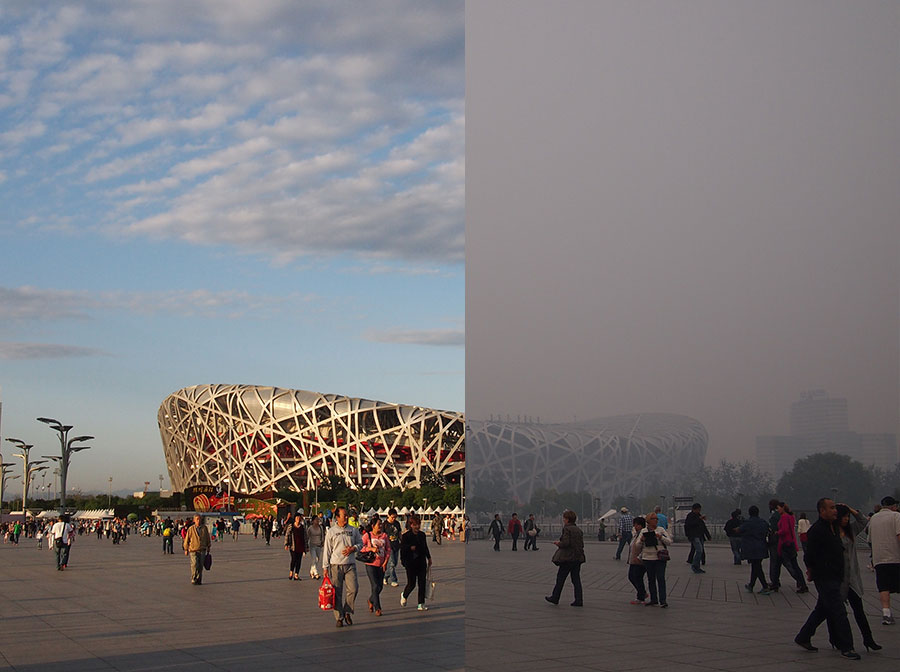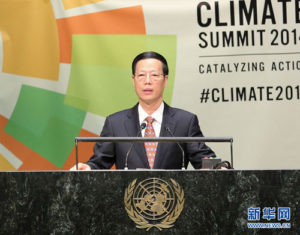Breathing Together, Struggling Together

25 February 2014: Xi Jinping ‘breathing the same air and sharing the common fate’
Source: talk.takungpao.com
On 25 February 2014, the concentration of fine particulate matter, known as PM2.5, reached 400 micrograms per cubic metre of air in Beijing, hazardous by the standards of both the American Environmental Protection Agency and China’s own air quality index system. That same smoggy day, President Xi Jinping made an unannounced visit to a lane off the popular tourist street of Nanluoguxiang in the captial, talking with the people who lived there. The news report on his visit was subtitled ‘breathing the same air and sharing the common fate’同呼吸,共命运.
A slightly different slogan, ‘breathing the same air and sharing the common struggle’ 同呼吸,共奋斗 was China’s theme for the 2013 World Environment Day. At that time, the Ministry of Environmental Protection called on all citizens to do their part to protect the environment, and to realise the dream of a beautiful China with a blue sky, green earth and clean water.
On 10 September 2013, the State Council issued its Air Pollution Prevention Action Plan 大气污染防治行动计划 for implementation at the level of the provinces, autonomous regions and municipalities. The action plan links air quality to the health of China’s citizens, economic development, social stability and the Chinese Dream. At the same time, it emphasises that it could take five years to improve the air quality in the regions of Beijing, Tianjin and Hebei province; the Yangtze River Delta and the Pearl River Delta. It may take much longer to improve the air quality in the country as a whole. The ultimate goal for Beijing is to reduce the yearly average density of fine particulate matter to sixty micrograms per cubic metre.
In order to achieve its targets, the action plan lists ten policies, referred to as the National Ten 国十条. They cover the treatment of sewage, industrial restructuring along environmental principles, technological innovation, energy structure, energy saving and environmental protection, environmental and economic management, legal supervision, regional co-operation, monitoring and early warning of pollution events, the establishment of clear lines of responsibility and the mass mobilisation of the populace. The action plan stresses the need for broad social participation: a shared struggle to improve the quality of air that everyone breathes.
In January 2014, the Ministry of Environmental Protection and the thirty-one provinces, autonomous regions and municipalities signed ‘The Air Pollution control target responsibility book’ 大气污染防治目标责任书, pledging to work towards the plan’s goals.
Hebei province’s Yanzhao Metropolis Daily 燕赵都市报 called the book a good starting point — it showed goodwill and commitment. On the other hand, the paper warned that other action plans, on national housing policy, for example, had become little more than slogans. It advocated strengthening the system of accountability.
In the Same Boat 吴越同舟
Air and air pollution respect no borders. When air pollution levels rise in China, neighbouring countries are affected, particularly in the northeast. In fact, for some years airborne particulates traceable back to China have been discovered by monitoring stations as far away as California. On that same February day that Beijing PM2.5 levels reached 400, the South Korean capital Seoul reported a concentration of atmospheric pollutants two to three times the usual level. According to Japan’s Ministry of the Environment, more than ten municipalities in Japan issued air pollution warnings on 26 February.
Officials from South Korea and Japan have expressed a willingness to work together with China to reduce PM2.5. Some Japanese media outlets have used the old saying ‘Wu and Yue — in the same boat’ 吴越同舟 to describe how former enemies can put aside their points of difference to work for the common good. On 20 March 2014, environmental protection officials and atmospheric pollution experts from Japan, China and South Korea gathered in Beijing for the first time to discuss co-operative measures to control air pollution. About a month later, on 28–29 April, Daegu city in South Korea hosted the sixteenth two-day, tripartite meeting of environment ministers from China, South Korea and Japan.
South Korea had first proposed an annual meeting of environmental ministers, and it hosted the first one in 1999. The three countries take turns to host the summit. During the 2014 meeting, Li Ganjie 李干杰, China’s Deputy Minister of Environmental Protection met with Yoon Seon-kyu, the Korean Minister for the Environment and Ishihara Nobuteru, the Japanese Minister to discuss issues including atmospheric pollution and climate change. Yoon Seon-kyu said that air pollution problems are already affecting people’s health in the three countries.
The meeting concluded with a five-year agreement on priority areas of co-operation: air quality, biodiversity, the disposal of electronic waste, climate change, the protection of village environments and the protection of water and sea environments. The three countries also decided to hold regular meetings devoted to issues related to the atmosphere. (The first meeting had in fact already been held in March in Beijing; the second will take place in South Korea). The three countries will promote further collaboration among local governments, enterprises and research institutions, and share technologies and information on controlling carbon emissions.

9 October 2014: Pollution from north-eastern China blows over the Bohai Sea on its way to Korea and Japan
Source: earthobservatory.nasa.gov
Ishihara Nobuteru and Yoon Seon-kyo also agreed to share information on PM2.5 levels and conduct scientific research on trans-border air pollution, encouraging China to join in. Li Ganjie, who blamed China’s air pollution on long-term industrialisation, indicated that China’s attitude is positive and open to three-sided or bilateral co-operation with South Korea and Japan.
A Rumour in Inner Mongolia
On 18 May 2014, a newspaper in Beijing reported that 300 polluting enterprises would move out of Beijing by October. The newspaper said that Beijing would ban twelve high-polluting industries such as lime, stone, architectural ceramics, casting, forging, printing and dyeing from the city. These would move to nearby cities in Hebei, around Tianjin and in Inner Mongolia once they had upgraded their technologies to eliminate or ameliorate pollution.
The news spread fear through the communities surrounding Beijing. People worried that the industries that had polluted Beijing would now move en masse and un-reconstructed, to pollute their hometowns. A microblogger in Inner Mongolia who posted a protest against what he (mistakenly) described as ‘three hundred polluted enterprises moving from Beijing to Inner Mongolia’. He wrote: ‘An individual may be powerless, but united, our power is infinite … our hometown is not a garbage dump! Please forward this message, friends of Inner Mongolia, so that our children can breathe clean air. Thank you!’ Arrested for spreading rumours, the authorities sentenced the microblogger to ten days of administrative detention and a fine of 500 yuan. Inner Mongolia was keen to make clear that it was not about to share Beijing’s destiny, at least not in terms of air pollution.
‘Chindia’ 中印大同
China, the United States of America, the European Union and India are the world’s biggest contributors to global emissions, generating more than half of global greenhouse gases in 2013. Yet neither President Xi Jinping of China nor Prime Minister Narendra Modi of India were among the 120 heads of state who attended the United Nations Climate Summit held on 23 September 2014 in New York, where one of the main topics was reducing greenhouse gas emissions. Xi did, however, send Vice-Premier Zhang Gaoli 张高丽 as his special envoy.
One week before the Summit, China’s State Council approved the ‘National Climate Change Plan (2014–2020)’ 国家应对气候变化规划 (2014–2020), which pledges that by 2020 China will reduce its carbon emissions per unit of GDP by forty to forty-five percent from 2005 levels. At the UN summit, Zhang Gaoli stressed that China is committed to working with international partners to respond actively to the challenge of climate change. Zhang promised that China would soon be announcing its post-2020 plan. Zhang also said that China would energetically promote South–South co-operation on climate change and provide US$6 million to support the United Nations Secretary General in advancing this co-operation. Furthermore, China would double its financial support from next year with the establishment of a co-operation fund.
The Chinese government has long been criticial of the domination of international negotiations on climate change by developed countries. South–South co-operation enables a strategic alliance between China and other developing or newly industrialised countries to resist what they consider to be unreasonable pressure from developed countries. In 2009, a Chinese government initiative united China, Brazil, South Africa and India in BASIC 基础四国. BASIC is a collective of newly industrialised countries committed to acting jointly on climate change. A month before the UN Climate Summit 2014, New Delhi hosted the eighteenth BASIC Ministerial Meeting on Climate Change, which reaffirmed the importance of the principle of ‘common but differentiated responsibilities’.
A week later, Chinese Vice-Premier Zhang Gaoli met with representatives of ‘developing countries with similar positions’ 立场相近的发展中国家. Chief among these is India. China has consistently advocated a joint strategy and a united voice for what the Chinese call Zhong Yin datong 中印大同 (loosely, ‘the Sino-Indian Commonwealth’) and Indian MP Jairam Ramesh has named ‘Chindia’. It is clear that the issue of air pollution is one of shared destiny with India, as it is with China’s neighbours to the northeast — and the world at large.
Notes
‘Xi Jinping visited Nanluogu Lane in Beijing in the smog: breathing the same air and sharing the common fate’ 习近平雾霾中走访北京南锣鼓巷:同呼吸 共命运, 26 February 2014, online at: http://news.qq.com/a/20140225/021865.htm
China State Council 国务院, ‘Air Pollution Prevention Action Plan’ 大气污染防治行动计划, 10 September 2013, online at: http://www.gov.cn/zwgk/2013-09/12/content_2486773.htm
‘The Ministry of Environmental Protection and the thirty one provinces, autonomous regions and municipal cities signed “the air pollution control target responsibility book”’ 环保部与31省(区,市)签大气污染防治目标责任书, 9 January 2014, online at: http://scitech.people.com.cn/n/2014/0109/c1057-24069262.html
Long Minfei 龙敏飞, ‘The accountability needs to be strengthened’ 签下“雾霾责任书” ,问责不能落空, 9 January 2014, online at: http://epaper.yzdsb.com.cn/201401/09/487365.html
‘PM2.5: more than ten municipalities had issued a warning of air pollution’ PM2.5:注意喚起の自治体過去最多10府県に, 26 February 2014, online at: http://mainichi.jp/feature/news/20140227k0000m040087000c.html
‘PM2.5, trans-boundary pollution, Japan, China and South Korea join hands and start dialogue’ PM2.5越境汚染、立ち向かう日中韓、不和超え、政策対話, 21 March 2014, online at: http://www.asahi.com/articles/DA3S11040748.html
‘China, Japan and South Korea make joint effort on PM2.5’ 中日韩环境部长会议落幕, 商定共同防控PM2.5, 29 April 2014, online at: http://world.huanqiu.com/exclusive/2014-04/4983366.html
‘Three hundred polluting enterprises will move out from Beijing before end of October’ 300家污染企业10月底前离京, 18 May 2014, online at: http://epaper.jinghua.cn/html/2014-05/18/content_90073.htm
‘“Moving the 300 polluting enterprises to Inner Mongolia” was a rumour, the first person who spread this rumour has been detained’ ” 300家污染企业迁到内蒙古”系谣言,首发者被行拘, 3 June 2014, online at: http://www.chinanews.com/sh/2014/06-03/6239091.shtml
Pep Canadell and Micheal Raupach, ‘Global carbon report: emissions will hit new heights in 2014’, The Conversation, 22 September 2014, online at: http://theconversation.com/global-carbon-report-emissions-will-hit-new-heights-in-2014-31834
‘China’s State Council: to reduce carbon dioxide emissions per unit of GDP by 40% by 2020’ 国务院:2020年单位GDP二氧化碳要下降40%, 19 September 2014, online at: http://politics.people.com.cn/n/2014/0919/c70731-25694942.html
‘Zhang Gaoli attends UN Climate Summit and delivers speech’, 24 September 2014, online at: http://www.fmprc.gov.cn/mfa_eng/zxxx_662805/t1194544.shtml
‘The role and influence of “BASIC” in international negotiations on climate change’气候变化国际谈判中”基础四国”机制的作用和影响, 15 September 2014, online at: http://world.people.com.cn/n/2014/0915/c187656-25663802.html
‘The eighteenth BASIC ministerial meeting on climate change held in New Delhi’第十八次”基础四国”气候变化部长级会议在印度新德里举行, 12 August 2014, online at: http://www.sdpc.gov.cn/tpxw/201408/t20140812_622015.html
‘Zhang Gaoli met with some representatives of climate change negotiations co-ordination from similar positions of developing countries’ 张高丽会见”立场相近发展中国家”气候变化谈判协调会代表, 3 September 2014, online at: http://news.xinhuanet.com/politics/2014-09/03/c_1112350303.htm
‘Domestic and external force called for co-operation in “Chindia” on climate change’内需外逼呼吁气候变化合作的”中印大同”, 25 March 2010, online at: http://www.china.com.cn/international/txt/2010-03/25/content_19645535_2.htm





